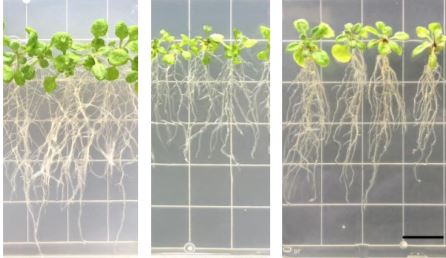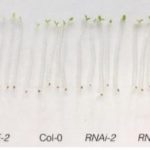Buffering lipid synthesis by conditional inhibition
Author:
Trevor H. Yeats, Email: [email protected]
Plant Breeding & Genetics Section, School of Integrative Plant Science, Cornell University, Ithaca NY USA
(Commentary on Liu et al.)
Lipid synthesis is a ubiquitous, but costly branch of primary metabolism in plants. All cells must make fatty acids as precursors for cellular membranes and signaling molecules, and some cells make large quantities of fatty acid-derived products, such as oils (triacylglycerol) or cuticles (wax and cutin). Accordingly, plants have evolved robust mechanisms for regulating lipid biosynthesis. These include the conserved transcriptional activator WRINKLED1 (WRI1) and post-translational regulation of lipid biosynthetic enzymes. In this issue of Plant Physiology, Liu and Zhai et al. (2019) reveal how WRI1 induces expression of inhibitors of fatty acid synthesis, while also promoting expression of associated biosynthetic genes. This counterintuitive coupling of transcriptional activation to post-translational inhibition illustrates how regulatory networks can evolve to refine control of metabolic processes.
In plants, fatty acid synthesis depends on two large plastid-localized enzyme complexes: Acetyl-CoA Carboxylase (ACCase) and Fatty Acid Synthase (FAS). ACCase produces the primary substrate of FAS, malonyl-CoA, so its activity is rate-limiting for the production of fatty acids. In most plants, with the notable exception of the grasses, plastid-localized ACCase consists of four distinct subunits: biotin carboxyl carrier protein (BCCP), biotin carboxylase (BC), and α- and β-subunits of carboxyltransferase (CT). The synthesis of malonyl-CoA occurs in two steps: first, the biotin attached to BCCP is carboxylated by the action of BC, and then the carboxyl moiety is transferred to acetyl-CoA by the action of CT, yielding malonyl-CoA.
Biotin attachment domain-containing proteins (BADCs) are homologs of BCCP that lack a conserved biotin-anchoring lysine, and thus do not participate directly in ACCase catalysis. Rather, BADCs have been shown to inhibit ACCase by competing for occupancy of the BCCP site of ACCase (Salie et al., 2016, Keereetaweep et al., 2018). BADC-mediated inhibition of ACCase is important for regulation of ACCase in the context of seed oil synthesis, since BADC mutants accumulate up to 30% more triacylglycerol (Salie et al., 2016; Keereetaweep et al., 2018). BADC proteins are also likely involved in feedback regulation of ACCase, as irreversible inhibition of ACCase in response to excess fatty acids is mediated by BADCs (Keereetaweep et al., 2018).
Now, Liu and Zhai et al. (2019) have revealed a seemingly paradoxical twist in the regulation of ACCase. WRI1, a transcriptional regulator of lipid synthesis, binds to the promoters of BADC-encoding genes and activates their transcription, while similarly promoting expression of the functional BCCP subunit of ACCase. Why do plants keep a foot on the gas pedal and the brake at the same time? The authors suggest that this may be important for moderating excess induction of lipid biosynthesis. Consistent with this idea, badc1badc2 double mutants phenocopy wri1 mutants with regard to impaired root growth and auxin homeostasis, highlighting the need for tight control of lipid synthesis during development.
The regulation of lipid synthesis is of considerable practical interest, since oilseed crops are a predominant source of triacylglycerols for food and industrial applications. This new understanding of how WRI1 and BADCs are involved in regulating ACCase activity sets the stage for some novel approaches to increasing oil content in crops. Specifically, gene editing technologies, such as CRISPR, enable targeted promoter engineering that could be used to tune or eliminate the binding of WRI1 to BADC promoters during seed filling. This might afford a direct increase in lipid synthesis, or alleviate regulatory bottlenecks that have limited the effectiveness of other strategies for lipid metabolic engineering (Bates 2016). Of course, it would be wise to anticipate the discovery of even more wrinkles in the regulatory network of lipid synthesis.
References:
Bates PD (2016) Understanding the control of acyl flux through the lipid metabolic network of plant oil biosynthesis. Biochimica et Biophysica Acta (BBA) – Molecular and Cell Biology of Lipids 1861: 1214–1225
Keereetaweep J, Liu H, Zhai Z, Shanklin J (2018) Biotin attachment domain-containing proteins irreversibly inhibit acetyl CoA carboxylase. Plant Physiology 177: 208–215
Liu H, Zhai Z, Kuczynski K, Keereetaweep J, Schwender J, Shanklin J (2019) WRINKLED1 regulates BIOTIN ATTACHMENT DOMAIN-CONTAINING proteins that inhibit fatty acid synthesis. Plant Physiology pp.00587.2019
Salie MJ, Zhang N, Lancikova V, Xu D, Thelen JJ (2016) A family of negative regulators targets the committed step of de novo fatty acid biosynthesis. The Plant Cell 28: 2312–2325




